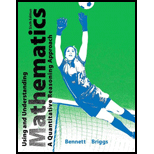
Concept explainers
a)
The guidelines for establishing causality for the following test: “The headaches occur only on days when you go to work” and to explain the guidelines. Also we have to give the reasonable conclusion about the cause of the headache.
b)
The guidelines for establishing causality for the following test: “If you stop drinking Coke at lunch on days when you go to work, the headaches persist.” and to explain the guidelines. Also we have to give the reasonable conclusion about the cause of the headache.
c)
The guidelines for establishing causality for the following test: “In the summer, the headaches occur less frequently if you open the windows of your office slightly. They occur even less often if you open the windows of your office fully.” and to explain the guidelines. Also we have to give the reasonable conclusion about the cause of the headache.
Want to see the full answer?
Check out a sample textbook solution
Chapter 5 Solutions
Using and Understanding Mathematics: A Quantitative Reasoning Approach plus NEW MyMathLab with Pearson eText -- Access Card Package (6th Edition) (Bennett Science & Math Titles)
- The graph of f(x) is given below. Select each true statement about the continuity of f(x) at x = 3. Select all that apply: 7 -6- 5 4 3 2 1- -7-6-5-4-3-2-1 1 2 3 4 5 6 7 +1 -2· 3. -4 -6- f(x) is not continuous at a = 3 because it is not defined at x = 3. ☐ f(x) is not continuous at a = - 3 because lim f(x) does not exist. 2-3 f(x) is not continuous at x = 3 because lim f(x) ‡ ƒ(3). →3 O f(x) is continuous at a = 3.arrow_forward1.5. Run Programs 1 and 2 with esin(x) replaced by (a) esin² (x) and (b) esin(x)| sin(x)|| and with uprime adjusted appropriately. What rates of convergence do you observe? Comment.arrow_forwardIs the function f(x) continuous at x = 1? (z) 6 5 4 3. 2 1 0 -10 -9 -7 -5 -2 -1 0 1 2 3 4 5 6 7 8 9 10 -1 -2 -3 -4 -5 -6 -7 Select the correct answer below: ○ The function f(x) is continuous at x = 1. ○ The right limit does not equal the left limit. Therefore, the function is not continuous. ○ The function f(x) is discontinuous at x = 1. ○ We cannot tell if the function is continuous or discontinuous.arrow_forward
- Use Taylor Series to derive the entries to the pentadiagonal and heptadiagonal (septadiagonal?) circulant matricesarrow_forwardIs the function f(x) shown in the graph below continuous at x = −5? f(x) 7 6 5 4 2 1 0 -10 -9 -8 -7 -6 -5 -4 -3 -2 -1 0 1 2 3 4 5 6 7 8 9 10 -1 -2 -3 -4 -5 -6 -7 Select the correct answer below: The function f(x) is continuous. ○ The right limit exists. Therefore, the function is continuous. The left limit exists. Therefore, the function is continuous. The function f(x) is discontinuous. ○ We cannot tell if the function is continuous or discontinuous.arrow_forward1.3. The dots of Output 2 lie in pairs. Why? What property of esin(x) gives rise to this behavior?arrow_forward
- 1.6. By manipulating Taylor series, determine the constant C for an error expansion of (1.3) of the form wj−u' (xj) ~ Ch¼u (5) (x;), where u (5) denotes the fifth derivative. Based on this value of C and on the formula for u(5) (x) with u(x) = esin(x), determine the leading term in the expansion for w; - u'(x;) for u(x) = esin(x). (You will have to find maxε[-T,T] |u(5) (x)| numerically.) Modify Program 1 so that it plots the dashed line corresponding to this leading term rather than just N-4. This adjusted dashed line should fit the data almost perfectly. Plot the difference between the two on a log-log scale and verify that it shrinks at the rate O(h6).arrow_forward4. Evaluate the following integrals. Show your work. a) -x b) f₁²x²/2 + x² dx c) fe³xdx d) [2 cos(5x) dx e) √ 35x6 3+5x7 dx 3 g) reve √ dt h) fx (x-5) 10 dx dt 1+12arrow_forwardDefine sinc(x) = sin(x)/x, except with the singularity removed. Differentiate sinc(x) once and twice.arrow_forward
- 1.4. Run Program 1 to N = 216 instead of 212. What happens to the plot of error vs. N? Why? Use the MATLAB commands tic and toc to generate a plot of approximately how the computation time depends on N. Is the dependence linear, quadratic, or cubic?arrow_forwardShow that the function f(x) = sin(x)/x has a removable singularity. What are the left and right handed limits?arrow_forward18.9. Let denote the boundary of the rectangle whose vertices are -2-2i, 2-21, 2+i and -2+i in the positive direction. Evaluate each of the following integrals: (a). 之一 dz, (b). dz, (b). COS 2 coz dz, dz (z+1) (d). z 2 +2 dz, (e). (c). (2z+1)zdz, z+ 1 (f). £, · [e² sin = + (2² + 3)²] dz. (2+3)2arrow_forward
 Discrete Mathematics and Its Applications ( 8th I...MathISBN:9781259676512Author:Kenneth H RosenPublisher:McGraw-Hill Education
Discrete Mathematics and Its Applications ( 8th I...MathISBN:9781259676512Author:Kenneth H RosenPublisher:McGraw-Hill Education Mathematics for Elementary Teachers with Activiti...MathISBN:9780134392790Author:Beckmann, SybillaPublisher:PEARSON
Mathematics for Elementary Teachers with Activiti...MathISBN:9780134392790Author:Beckmann, SybillaPublisher:PEARSON
 Thinking Mathematically (7th Edition)MathISBN:9780134683713Author:Robert F. BlitzerPublisher:PEARSON
Thinking Mathematically (7th Edition)MathISBN:9780134683713Author:Robert F. BlitzerPublisher:PEARSON Discrete Mathematics With ApplicationsMathISBN:9781337694193Author:EPP, Susanna S.Publisher:Cengage Learning,
Discrete Mathematics With ApplicationsMathISBN:9781337694193Author:EPP, Susanna S.Publisher:Cengage Learning, Pathways To Math Literacy (looseleaf)MathISBN:9781259985607Author:David Sobecki Professor, Brian A. MercerPublisher:McGraw-Hill Education
Pathways To Math Literacy (looseleaf)MathISBN:9781259985607Author:David Sobecki Professor, Brian A. MercerPublisher:McGraw-Hill Education





